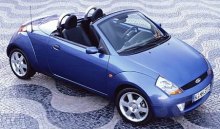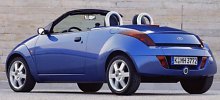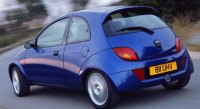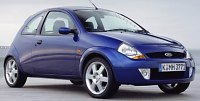StreetKa
 From
the back, StreetKa looks very much like a mini version of Audi TT
Roadster. So alike that everybody can see this is no coincidence, just
like what we have said about Daihatsu Copen. Now we know Japanese car
makers
are not alone to be copycats. And Turin is probably not as creative as
we thought. From
the back, StreetKa looks very much like a mini version of Audi TT
Roadster. So alike that everybody can see this is no coincidence, just
like what we have said about Daihatsu Copen. Now we know Japanese car
makers
are not alone to be copycats. And Turin is probably not as creative as
we thought.
Why? because
StreetKa was
designed by the once-famous Ghia studio in Turin in early 2000, before
Ford sacked 95% of its staffs. The design got the approval from Ford
thanks
to its pretty look and, more important, low cost layout. Obviously, it
is built around a Ford Ka. Clever wheelarch panels change the shape of
the headlamps and widen tracks (by 22mm front, 35mm rear) to ensure
better
handling. Lower and more steeply raked windscreen contribute to a coupe
feel. New bumpers look more sporty. Swoopy rear end with new rear
lights,
neat hood cover and chromed rollover bars look just like TT Roadster.
Ghia
proves that a complete change of visual effect is not necessarily
expensive.
The production
StreetKa was
refined by Pininfarina because it is also manufactured there. Ford’s
accountant
found that projection sales is just 20,000 cars per year, not justify
to
set up a new production line by itself. At the same time, Pininfarina
has
a plant with a lot of unused capacity due to the death of Fiat Coupe
and
Peugeot 306 Cabriolet, thus a deal with Ford was made. Therefore,
StreetKa
has Latin blood in its body. It is designed by Italian and built in
Italy
with many components coming from Spain where Ka is made.
 Unfortunately,
cost concern limits StreetKa in many ways. Firstly, the interior is
virtually
unchanged from the cheap Ka - the same early-90’s organic design, hard
and shinny plastic. Secondly, the roof is a manually-operated fabric
soft
roof. How can this compete with the popular electric folding hardtop
from
its rivals, namely Peugeot 206 CC and Daihatsu Copen? even Smart
Roadster
has the option for electric soft roof, while the little Ford doesn’t.
Thirdly,
the StreetKa is powered by a bigger and more powerful engine in
relation
to the standard Ka, but it is just a 95hp single-cam
2-valve-per-cylinder
1.6-litre from the South African Ford Ka. Better than the standard
car’s
1.3 push-rod design, but too outdated compare with the 16-valver from
Peugeot.
It is noisy at over 4500rpm and lacks punch to cope with the 1061kg
kerb
weight. 0-60mph takes more than 11 seconds, too slow. Unfortunately,
cost concern limits StreetKa in many ways. Firstly, the interior is
virtually
unchanged from the cheap Ka - the same early-90’s organic design, hard
and shinny plastic. Secondly, the roof is a manually-operated fabric
soft
roof. How can this compete with the popular electric folding hardtop
from
its rivals, namely Peugeot 206 CC and Daihatsu Copen? even Smart
Roadster
has the option for electric soft roof, while the little Ford doesn’t.
Thirdly,
the StreetKa is powered by a bigger and more powerful engine in
relation
to the standard Ka, but it is just a 95hp single-cam
2-valve-per-cylinder
1.6-litre from the South African Ford Ka. Better than the standard
car’s
1.3 push-rod design, but too outdated compare with the 16-valver from
Peugeot.
It is noisy at over 4500rpm and lacks punch to cope with the 1061kg
kerb
weight. 0-60mph takes more than 11 seconds, too slow.
The chassis is
better. Basically,
Ford Ka is always good at handling. Base on its chassis, StreetKa uses
stiffer suspensions - stiffer front springs, rear torsion-beam axle
taken
from the late Puma - and 195/45 VR16 wheels and tires to improve
handling.
Bigger brakes come from Focus. Its chassis isn’t as strong as the
tin-top
car, but reinforced rear bulkhead and the rollover bars make it strong
enough for a convertible. The result is sure-footed cornering. Steering
is faithful, ride is supple, body roll is well checked, grip level is
high.
However, perhaps the tires are too wide. The power is too weak to
overcome
the grip limit, thus it is far more difficult to induce lift-off
oversteering
than the standard Ka. This means StreetKa actually delivers less fun to
drive.
|
 The
term "Ultra mini" suits Ford Ka very much. It means "ultra small" and
"superior
than a super mini" simultaneously.
The
term "Ultra mini" suits Ford Ka very much. It means "ultra small" and
"superior
than a super mini" simultaneously.
 Besides,
what the Fiesta lacks became the strongest points in Ka - pretty and
artistic
styling ( one of my favourite designs of all time ), highest build
quality,
brilliant packaging which enhances interior space despite of small
dimensions,
and the young-looking interior design.
Besides,
what the Fiesta lacks became the strongest points in Ka - pretty and
artistic
styling ( one of my favourite designs of all time ), highest build
quality,
brilliant packaging which enhances interior space despite of small
dimensions,
and the young-looking interior design.  Despite
of its name, SportKa is not a sport car. Not even a hot hatch. You can
at most call it a "warm hatch", because it has a power-to-weight ratio
just 100hp per ton, finishing 0-60mph in close to 10 long seconds and
tops
just a bit over 100mph. When you do that, you are accompany with harsh
noise from the reluctant old-tech engine.
Despite
of its name, SportKa is not a sport car. Not even a hot hatch. You can
at most call it a "warm hatch", because it has a power-to-weight ratio
just 100hp per ton, finishing 0-60mph in close to 10 long seconds and
tops
just a bit over 100mph. When you do that, you are accompany with harsh
noise from the reluctant old-tech engine.
 SportKa
is the twins sister of the StreetKa. Both cars share the same styling
tweaks
around bumpers and wheelarches. The single-cam 1.6-litre 95hp engine is
the same, so are the wheels, firmer suspension setting, bigger brakes,
transmission etc. The tin-top SportKa is 127kg lighter than the
cabriolet
StreetKa, this account for its performance gain.
SportKa
is the twins sister of the StreetKa. Both cars share the same styling
tweaks
around bumpers and wheelarches. The single-cam 1.6-litre 95hp engine is
the same, so are the wheels, firmer suspension setting, bigger brakes,
transmission etc. The tin-top SportKa is 127kg lighter than the
cabriolet
StreetKa, this account for its performance gain.  From
the back, StreetKa looks very much like a mini version of Audi TT
Roadster. So alike that everybody can see this is no coincidence, just
like what we have said about Daihatsu Copen. Now we know Japanese car
makers
are not alone to be copycats. And Turin is probably not as creative as
we thought.
From
the back, StreetKa looks very much like a mini version of Audi TT
Roadster. So alike that everybody can see this is no coincidence, just
like what we have said about Daihatsu Copen. Now we know Japanese car
makers
are not alone to be copycats. And Turin is probably not as creative as
we thought.
 Unfortunately,
cost concern limits StreetKa in many ways. Firstly, the interior is
virtually
unchanged from the cheap Ka - the same early-90’s organic design, hard
and shinny plastic. Secondly, the roof is a manually-operated fabric
soft
roof. How can this compete with the popular electric folding hardtop
from
its rivals, namely Peugeot 206 CC and Daihatsu Copen? even Smart
Roadster
has the option for electric soft roof, while the little Ford doesn’t.
Thirdly,
the StreetKa is powered by a bigger and more powerful engine in
relation
to the standard Ka, but it is just a 95hp single-cam
2-valve-per-cylinder
1.6-litre from the South African Ford Ka. Better than the standard
car’s
1.3 push-rod design, but too outdated compare with the 16-valver from
Peugeot.
It is noisy at over 4500rpm and lacks punch to cope with the 1061kg
kerb
weight. 0-60mph takes more than 11 seconds, too slow.
Unfortunately,
cost concern limits StreetKa in many ways. Firstly, the interior is
virtually
unchanged from the cheap Ka - the same early-90’s organic design, hard
and shinny plastic. Secondly, the roof is a manually-operated fabric
soft
roof. How can this compete with the popular electric folding hardtop
from
its rivals, namely Peugeot 206 CC and Daihatsu Copen? even Smart
Roadster
has the option for electric soft roof, while the little Ford doesn’t.
Thirdly,
the StreetKa is powered by a bigger and more powerful engine in
relation
to the standard Ka, but it is just a 95hp single-cam
2-valve-per-cylinder
1.6-litre from the South African Ford Ka. Better than the standard
car’s
1.3 push-rod design, but too outdated compare with the 16-valver from
Peugeot.
It is noisy at over 4500rpm and lacks punch to cope with the 1061kg
kerb
weight. 0-60mph takes more than 11 seconds, too slow.